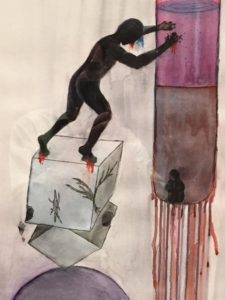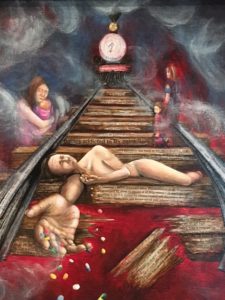My eyes were opened a little bit wider this week as I recently attended a conference on the opioid crisis. After a few of the numbers I heard, it is apparent to me that the medical community as a whole can do better at helping to solve and prevent this problem. Probably the most concerning evidence was that 4 out of 5 heroin users started with prescription medications. That’s a heavy statistic.
I was also struck by the opioid crisis images at the conference. Bitter Pill – Montana Lives Affected by Drug Abuse, was an art display, depicting the fear, anger, loneliness and helplessness of opioid addiction. With permission, I took a couple of photos that really hit me hard.

Courtesy Amanda Dunlap

Courtesy Angie Sellars
The day after I got home from this conference, here’s the image that was all over the news.

This isn’t going away anytime soon. If you are healthcare professional, do your best to educate yourself about the disease state of addiction and step in where you can to provide education and guidance to your community.
Please feel free to share this post to help spread the word about the utter destruction that addiction can do to our people and communities.


Yes we must be aware of this problem. However, the pendulum is swinging the other way for pain management for a lot of our patients. I myself experienced severe pain with a torn muscle in the shoulder area. I could not raise my arm for 2 months.the pain was unbearable. I could not sleep.
I was able to get a mild narcotic ( tylenol#2) around the clock for pain control. But I was waking up when it wore off at night. My physician was afraid to prescribe something stronger, because of this nonsense worrying about addiction. Anyways , the pain got better after 2.5 months, and I stopped taking the meds. I do take occasionally, when I have over used my arm. No issues with addiction for me.
Moral of the story.. Be cautious about addiction, but understand pain management as well. Do not deny the patient opioids for pain as needed. As well, some people may take longer to get better and others less. My diagnosis was delayed because the ultrasound did not show much. When I insisted on an MRI, that is when they found the torn muscle. So I had severe pain, but it appeared to be psychosomatic until I got properly diagnosed. By the way, I was able to work for the 2.5 months while I was taking the Tylenol”# 2 around the clock as it did not affect me cognitively. I know that if I was not able to have the narcotics, I would not be able to work . I probably would have suffered in bed with pain ..
Thank you for spending time to highlight this issue! I would like to direct your attention to the US Surgeon General’s campaign to address this issue at http://turnthetiderx.org/#. You can also sign a pledge expressing your support.
Should the opportunity arise at our local places of practice, you may find the resources available on the website useful in planning and implementing a strategy to reduce the incidence and prevalence of this problem.
That statistic 4 out of 5 start with rx medication is not entirely accurate.. If you look at the data majority of heroin abusers start from non medical pain reliever use which is illicit use… Majority of overdose deaths from the opioid crisis is from illicit fentanyl and poly substance use… Legitimate pain patients who get rx from physicians rarely overdose…
https://www.painnewsnetwork.org/stories/2018/4/23/do-80-of-heroin-users-really-start-with-a-prescription?format=amp&__twitter_impression=true